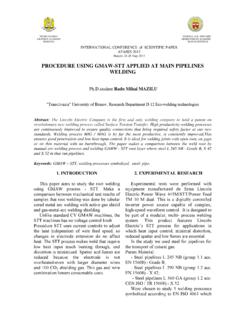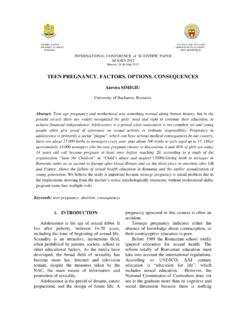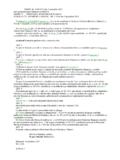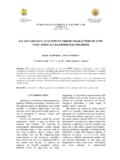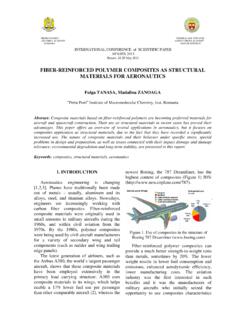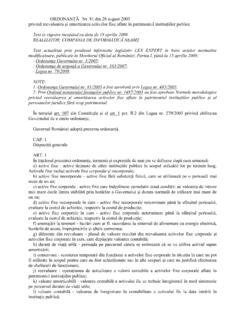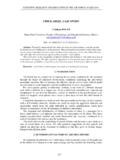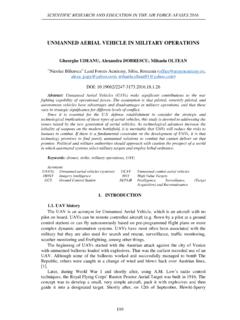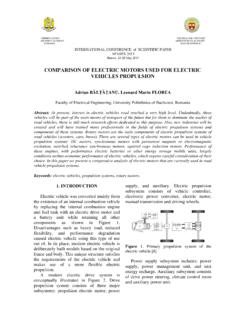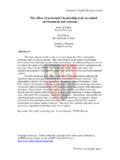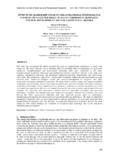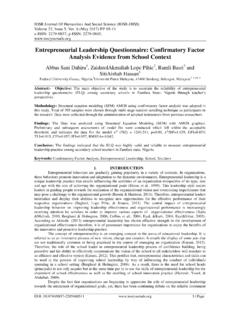Transcription of TEACHERS’ LEADERSHIP STYLE IN THE …
1 HENRI COANDA GENERAL STEFANIK AIR FORCE ACADEMY ARMED FORCES ACADEMY ROMANIA SLOVAK REPUBLIC INTERNATIONAL CONFERENCE of SCIENTIFIC PAPER AFASES 2012 Brasov, 24-26 May 2012 TEACHERS LEADERSHIP STYLE IN THE CLASSROOM AND THEIR IMPACT UPON HIGH SCHOOL STUDENTS Loredana DROBOT*, Monica RO U** *Faculty of Theology, Social and Educational Sciences, University Eftimie Murgu of Re i a, Romania ** Faculty of Economics, University Eftimie Murgu of Re i a, Romania Abstract: The teacher , in the educational process, plans, organises and controls students activity and thus he / she appears in the leader s position.
2 Irrespective of the concrete content of the manager teacher s activity his / her work falls within one of the following activities; information processing, engaging in interpersonal relations and decision making. Research purpose: investigating students perceptions about the impact of teachers LEADERSHIP styles in the classroom upon their psychosocial development. Research objectives: 1. Analysis of the teacher -student relationship in relation with the way the students feel these interactions; 3. Exploration of the pupils opinions regarding the characteristics of the desired teacher . Research hypotheses: 1. If teacher -students relations are based on co-operation and involvement then the students level of satisfaction towards the activity performed; 2.
3 If teacher -students relations are based on encouragement in participation, students get the feeling they are in control of the activities they are bout to deploy; 3. If the teacher exhibits communication and relationing skills, and has also vocation, in the vision of pupils he / she is the ideal teacher . Methodology: The method of research was the opinion poll inquiry. The sample was made of 300 high school students. Conclusions: The way in which a teacher organises his / her relations with the students is the most important ingredient for the subject assimilation; suggesting lifelong training programmes for the teachers with modules of pupil-focused learning; training teachers in pupil-focused counselling, modules of personal development destined to teachers.
4 Keywords: LEADERSHIP STYLE , teacher -student relationship, student-focused learning. 1. INTRODUCTION The teacher , in the educational process, plans, organises and controls the students' activity and consequently appears in the position of leader [2]. Studies conducted in the field of class management present the teacher s authoritative, democratic and laissez-faire LEADERSHIP styles . The authoritative LEADERSHIP STYLE means that the leader ( teacher ) makes all the decisions about the organisation of the group and the activities performed in the group. He or she does not share with the students the overall plan of activities, nor the criteria for assessing individual or group performances.
5 His / her evolution supposes keeping outside the group s concrete activities and exercising a strict control. The democratic LEADERSHIP STYLE . The democratic leader does not participate either too much in the activities. Nevertheless, he / she avoids to make decisions alone, and invites the group to participate in setting the organisation manner. The students are offered the opportunity to choose every time, their advice is sought regarding the task fulfilment: the leader suggests at least two alternatives, letting them decide themselves. The leader presents the common criteria of assessment and criticism he or she observes together with the students; he or she acts, in a way, like a member of the group.
6 The laissez-faire LEADERSHIP STYLE means a passive role of the leader, who limits his or her participation as much as possible, leaving the students to take all initiatives. He / she exhibits a friendly attitude but by all he or she does suggests indifference and non-involvement: he / she hesitates when put in the situation of offering suggestions and constantly avoids any evaluation of participants ideas or behaviours. Irrespective of the concrete content of the manager teacher s work, his or her actions fall within one of the following: processing information, engaging interpersonal relations and decision making [1]. The educator s roles are associated with the personal values and attitudes incorporated in the structure of each student s personality.
7 The students address to teachers to get advice only if the latter are close enough to students, if the former trust to be understood and well advised. When they do it, students do not address to any teachers but only to those who understand them. Students wish to have closer relations with teachers in order to find in the latter moral support whenever they need it [3]. The purpose of the research is to investigate the students perceptions related to the impact of teachers LEADERSHIP styles in the classroom upon their psychosocial development. The objectives are, on the one hand, to analyse the teacher -student relationship in relation with the way students feel these interactions, and on the other hand to explore the students opinions on the characteristics of the desired teacher .
8 2. RESEARCH HYPOTHESES AND METHODOLOGY Research hypotheses. 1. If teacher -student relations are based on co-operation and involvement, the students satisfaction level towards the activities increases. 2. If teacher -student relations are based on participation encouragement, the students get the feeling they are in control of the activities they are to perform. 3. If the teacher exhibits and proves communication and relationing skills and also has vocation, he / she is the ideal teacher . Methodology. The research was conducted by a study of the teachers LEADERSHIP styles in the classroom, performed from the perspective of the analyses of teacher -student relation and teachers characteristics, monitoring the way these interactions influence students attitudes and behaviours [4].
9 For formulating hypotheses, the following criteria were set for the two first hypotheses, the level of satisfaction and the degree of control, whereas for the third hypothesis the empathic capacity and the pedagogic talent. The research method was the opinion poll inquiry. The Questionnaire Teachers LEADERSHIP STYLE in the classroom comprises 6 items for which there are 3 answering options: a) to high extent; b) to medium extent; c) to low extent; and 1 item with free answer asking the students to list three essential characteristics of the ideal teacher . The subjects who answered the questionnaire were 300 high school students, enrolled in technical training in an industrial high school of Re i a.
10 Questionnaire structure. For the first 6 questions there are 3 answering variants. Choose the answer that best corresponds to your opinion: a) to high extent; b) to medium extent; c) to low extent. Questions: 1. Do you appreciate that the activity carried on in the classroom under the teacher s co-ordination offer you satisfactions? 2. Are there co-operation relations among the classmates, between them and the teachers in the fulfilment of the tasks? HENRI COANDA GENERAL STEFANIK AIR FORCE ACADEMY ARMED FORCES ACADEMY ROMANIA
